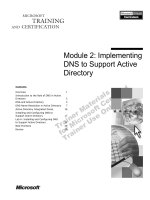Tài liệu E-business 2.0: Roadmap for Success - Chapter 6 docx
Bạn đang xem bản rút gọn của tài liệu. Xem và tải ngay bản đầy đủ của tài liệu tại đây (719.1 KB, 30 trang )
Chapter Six
Chapter Six
Integrating Processes to
Build Relationships:
Customer Relationship
Management
www.ebstrategy.
com
2 -
© e-Business Strategies,
Inc.
Introduction
Introduction
Customer dissatisfaction with service widespread
–
Expectations of customers higher than ever
–
“Does your company deserve my patronage and
loyalty?”
–
Starting point today: What was exceptional yesterday
Organizations with long-standing customer bases find they
lack the info and data to make good service decisions
–
90% companies don’t have sales and service integration
Companies must view their service encounter through the
eyes of their customers
–
To maintain ongoing relationships strong
–
Acquisition and selling costs of new customer very high
–
Dissatisfied customers primarily due to lack of customer
service
–
70% of complaining customers will do business again if
their complaint quickly addressed
www.ebstrategy.
com
3 -
© e-Business Strategies,
Inc.
The Basics of CRM
The Basics of CRM
Timely delivery of excellent service
Combination of business process and technology
When competition is fierce, companies go back to basics:
create value for customer
Execs must ask
–
Can their companies’ infrastructures allow value creation?
–
Can their companies’ existing CRM infrastructures support
doing business in the e-world
Only by integrating sales and service infrastructure with
all aspects of operations can management see change in
customer relationships
www.ebstrategy.
com
4 -
© e-Business Strategies,
Inc.
Top Demand Drivers in CRM Verticals
Top Demand Drivers in CRM Verticals
Telecommunications – Primary CRM applications include:
–
Multi-channel contact centers
–
Business intelligence
–
Customer data integration and analysis
–
Web-based billing systems
–
Marketing automation/campaign management systems
–
Mobile CRM
Banking and Financial Services – Primary CRM
applications include:
–
Profitability analysis
–
Target marketing
–
Data mining
–
Product personalization
Source: Gartner Group, 2001
www.ebstrategy.
com
5 -
© e-Business Strategies,
Inc.
Top Demand Drivers in CRM Verticals
Top Demand Drivers in CRM Verticals
Retail – Primary CRM applications use e-
commerce transaction and point-of-sale data to
drive:
–
One-to-one marketing
–
Cross selling
–
Personalized content management and
merchandizing
Source: Gartner Group, 2001
Few retailers are providing improved interaction but many
customers are demanding it --- this is an opportunity for
companies to distinguish themselves.
www.ebstrategy.
com
© e-Business Strategies,
Inc.
Strategic Business Drivers
Strategic Business Drivers
Are these “hot buttons” that influence your
business?
–
Customer-driven businesses
–
360-degree customer view
–
Personalization/one-to-one marketing
–
Complex and more diverse channels
–
Automated sales
–
Shrinking margins due to product commoditization
–
Scattered global customers
These are strategic level questions aimed at CxO
and other senior level executives to uncover CRM
opportunities.
www.ebstrategy.
com
7 -
© e-Business Strategies,
Inc.
Strategic Business Drivers
Strategic Business Drivers
This chapter
–
Clarify the concept of multi-channel organization
–
Discuss apps supporting customer-focused
business model
–
Discuss how marketing practices and systems must
be reworked to support ecommerce environment
Service levels on the Web today often leave a lot
to be desired. As buyers jump from site to site --
only to ultimately abandon the shopping cart
without buying anything from anyone -- revenues
slip away.
www.ebstrategy.
com
8 -
© e-Business Strategies,
Inc.
Defining CRM
Defining CRM
Integrated sales, marketing, and service strategy
–
precludes lone showmanship
–
depends on coordinated enterprise-wide actions
CRM software suite
–
Helps better manage customer relationships by
tracking customer interactions of all types
–
Automates selling and customer service cycle
•
direct-mail marketing campaigns, telemarketing,
telesales, lead qualification, response mgmt,
lead tracking, opportunity mgmt, quotes and
order configuration
www.ebstrategy.
com
9 -
© e-Business Strategies,
Inc.
Defining CRM
Defining CRM
Business Goals
–
Using existing relationships to grow revenue
–
Using integrated information for excellent service
–
Introducing consistent, replicable channel
processes and procedures
CRM is an
integrated
framework and
strategy, not
product
www.ebstrategy.
com
10 -
© e-Business Strategies,
Inc.
Managing the Customer Life Cycle:
Managing the Customer Life Cycle:
The Three Phases of CRM
The Three Phases of CRM
Differentiation
•
Innovation
•
Convenience
Acquire
E
n
h
a
n
c
e
R
e
t
a
i
n
Bundling
•
Reduce Cost
•
Customer Service
Adaptability
•
Listening
•
New Products
Metrics
•
Direct and indirect sales
•
Customer service
improvements
Metrics
•Tangible and intangible benefits
•Brand equity gains
Metrics
•
Lifetime value
•
Share of wallet
www.ebstrategy.
com
11 -
© e-Business Strategies,
Inc.
The New CRM Architecture: Organizing
The New CRM Architecture: Organizing
around the Customer
around the Customer
To determine how CRM and supporting tech will work
together for your firm, ask these questions
–
Are most of company’s apps designed simple to automate
existing departmental processes?
–
Are these apps capable of identifying and targeting best
customers, those who are the most profitable?
–
Are these apps capable of real-time customization of
products and services?
–
Do these apps track when the customer contacts the
company, regardless of the contact point?
–
Are these apps capable of creating a consistent user
experience across all contact points the customer chooses?
If answers to each is no, seriously consider CRM
architecture
www.ebstrategy.
com
12 -
© e-Business Strategies,
Inc.
The New CRM Architecture: Organizing
The New CRM Architecture: Organizing
around the Customer
around the Customer
Cross-Functional Processes
Breaking Down Departmental Walls
Acquire Enhance
Integrated CRM Applications
{
Retain
Direct Marketing
Sales Force Automation
Cross-Sell &
Up-Sell
Customer Support
Proactive
Service
Complete
Integrated
Solutions
Partial
Functional
Solutions
Customer
Lifecycle









